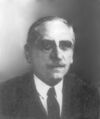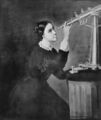Template:Selected anniversaries/June 28: Difference between revisions
No edit summary |
No edit summary |
||
| Line 17: | Line 17: | ||
||1852: Wilhelm Hisinger dies ... physicist and chemist who in 1807, working in coordination with Jöns Jakob Berzelius, noted that in electrolysis any given substance always went to the same pole, and that substances attracted to the same pole had other properties in common. This showed that there was at least a qualitative correlation between the chemical and electrical natures of bodies. Pic. | ||1852: Wilhelm Hisinger dies ... physicist and chemist who in 1807, working in coordination with Jöns Jakob Berzelius, noted that in electrolysis any given substance always went to the same pole, and that substances attracted to the same pole had other properties in common. This showed that there was at least a qualitative correlation between the chemical and electrical natures of bodies. Pic. | ||
||1873: Alexis Carrel born ... surgeon and biologist, Nobel Prize laureate ... Perfusion pump w/ Charles Lindbergh. Pic. | ||1873: Alexis Carrel born ... surgeon and biologist, Nobel Prize laureate ... Perfusion pump w/ Charles Lindbergh. Pic. | ||
File:Henri Lebesgue.jpg|link=Henri Lebesgue (nonfiction)|1875: Mathematician and academic [[Henri Lebesgue (nonfiction)|Henri Lebesgue]] born. He will gain fame for his his theory of integration, which generalizes the 17th century concept of integration (summing the area between an axis and the curve of a function defined for that axis). | File:Henri Lebesgue.jpg|link=Henri Lebesgue (nonfiction)|1875: Mathematician and academic [[Henri Lebesgue (nonfiction)|Henri Lebesgue]] born. He will gain fame for his his theory of integration, which generalizes the 17th century concept of integration (summing the area between an axis and the curve of a function defined for that axis). | ||
||1879: Wilhelm Steinkopf born ... chemist ... worked on the production of mustard gas during World War I. Pic search. | ||1879: Wilhelm Steinkopf born ... chemist ... worked on the production of mustard gas during World War I. Pic search. | ||
File:Maria Mitchell.jpg|link=Maria Mitchell (nonfiction)|1889: Astronomer and academic [[Maria Mitchell (nonfiction)|Maria Mitchell]] dies. She was the first American woman to work as a professional astronomer. | File:Maria Mitchell.jpg|link=Maria Mitchell (nonfiction)|1889: Astronomer and academic [[Maria Mitchell (nonfiction)|Maria Mitchell]] dies. She was the first American woman to work as a professional astronomer. | ||
| Line 65: | Line 59: | ||
||1972: Prasanta Chandra Mahalanobis dies ... scientist and applied statistician. He is best remembered for the Mahalanobis distance, a statistical measure and for being one of the members of the first Planning Commission of free India. Pic. | ||1972: Prasanta Chandra Mahalanobis dies ... scientist and applied statistician. He is best remembered for the Mahalanobis distance, a statistical measure and for being one of the members of the first Planning Commission of free India. Pic. | ||
||1981: A powerful bomb explodes in Tehran, killing 73 officials of the Islamic Republican Party. | ||1981: A powerful bomb explodes in Tehran, killing 73 officials of the Islamic Republican Party. | ||
Revision as of 20:07, 6 February 2022
1598: Cartographer and geographer Abraham Ortelius dies. Ortelius created the first modern atlas, the Theatrum Orbis Terrarum. He was also one of the first to imagine that the continents were joined together before drifting to their present positions.
1712: Philosopher and author Jean-Jacques Rousseau born. His political philosophy will influence the Enlightenment in France and across Europe.
1824: Physician, anatomist, and anthropologist Paul Broca born. He will discover that the brains of patients suffering from aphasia contain lesions in a particular part of the cortex, in the left frontal region -- the first anatomical proof of the localization of brain function.
1825: Chemist and academic Emil Erlenmeyer born. He will contribute to the early development of the theory of structure, formulating the Erlenmeyer rule, and designing the Erlenmeyer flask.
1875: Mathematician and academic Henri Lebesgue born. He will gain fame for his his theory of integration, which generalizes the 17th century concept of integration (summing the area between an axis and the curve of a function defined for that axis).
1889: Astronomer and academic Maria Mitchell dies. She was the first American woman to work as a professional astronomer.
1906: Physicist and academic Maria Goeppert-Mayer born. She will develop a mathematical model for the structure of nuclear shells, for which she will be awarded the Nobel Prize in Physics in 1963, which she will share with J. Hans D. Jensen and Eugene Wigner.






